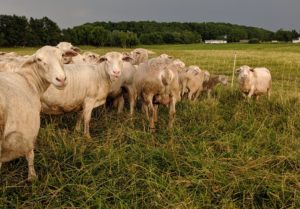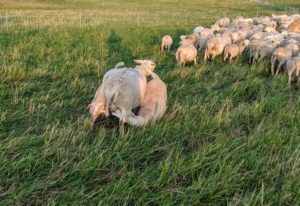Mastitis in Sheep
How to Reduce Cases of Mastitis in Your Flock
Mastitis is an inflammation of the udder caused by bacteria. It leads to a loss of milk production and the quality of the milk is affected. Depending on the various bacteria that can cause mastitis, it will be more or less severe. In most cases I experienced, the milk gets flaky and watery, the affected half of the udder is swollen, the ewe is running a fever and appears sad and often goes off feed. She will appear to limp in the rear on the side with the inflamed udder because she tries to avoid that the leg hits or rubs the udder, which causes pain or discomfort. These are cases that can be treated with antibiotics and the milk returns to normal. However, if undetected or treatment comes too late, the affected side of the udder hardens and will no longer produce milk. In some cases of mastitis, the milk turns brown and bloody. These cases are rare. It will lead to the literal loss of the half of the udder that is affected. It will eventually fall off. In some cases, the ewe will die despite of treatment.

Good udder health is important to raise twins.
Ulf Kintzel / White Clover Sheep Farm
Many years ago, I used to have several ewes each year that had mastitis in one half of the udder when they were nursing. While I don’t have exact records, I estimate that about four to five percent of all ewes were affected. I remember a year when it went up to about eight percent. In most cases, it went away when treated. Few had lasting problems after treatment with antibiotics. There was a bigger problem, though. Some cases were mild and went undetected. The ewe showed no symptoms, the disease was subclinical. That meant that these ewes were never treated and in the following year the ewe had one side of the udder hard and no longer produced milk in that half. If such ewe had twins, one of the lambs had to be removed. Twins don’t take turns when nursing. Usually, one eventually wins out and pushes the second away, which is now at risk of dying of starvation. Even if it survives, its growth rate will be significantly stunned. A surrogate mother needs to be found. That can be hard if you have several lambs like that. Raising the second lamb on milk replacer is an alternative. However, it is very costly.
There is a lot of advice in the literature that tells you what to do in order to reduce cases of mastitis in your flock. I dispute none of the advice but it either does not reduce mastitis to a satisfactory level (clean bedding) or is impossible to achieve (stopping lambs from stealing milk from other ewes). Then I read in an article that ewes that previously had mastitis and had been cured can be latent carriers of the bacteria causing mastitis. They no longer get ill themselves, but they can affect others when bedding in the barn or a lamb that is stealing milk goes from one ewe to the next. The recommendation was to cull the ewes that previously had mastitis. It appeared to make sense and I started doing that. That can be a painful decision when you start bringing ewes of best breeding age that seem to be perfectly healthy and productive after they had been cured to the butcher. However, I knew from people who eradicated hoof rot in a flock of sheep that they followed a similar principal, and they too culled those ewes that seemed perfectly productive but were the first to be affected time and again when the disease reared its head again. That knowledge allowed me to follow through when I started culling ewes that had caught mastitis despite of successfully curing these ewes.

This ewe had mastitis on the left side and no longer produces milk in that half, which led to stunted growth of one of her twin lambs.
Ulf Kintzel / White Clover Sheep Farm
It has been many years since I started this procedure. There were fewer and fewer ewes with the disease year after year. This year I had one ewe catching mastitis shortly after her lambs were born when she also broke her foot, and her health was already compromised, and her stress level was increased. After selling off some breeding stock first and then some market lambs, there is always some risk of mastitis when the lambs of ewes are removed that still produce ample milk. I had no additional cases of mastitis at that time. Altogether, that amounts to less than one percent of mastitis. Although it is entirely possible that I will still get a case this year, this describes well the dramatic reduction of mastitis in my flock.
There were no other changes in management that could account in my view for these positive results. I have to assume that cured ewes had indeed been latent carriers and had prolonged the problem. Keep that in mind when you look at that beautiful ewe that just raised twins and that you know needs to be culled now after she has been cured. It will not be an easy decision. I know. I have been there many times.

